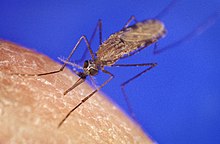| Airport malaria | |
|---|---|
| Other names |
|
 | |
| Anopheles gambiae mosquito | |
| Specialty | Infectious disease |
| Symptoms | Unexplained fever associated with
|
| Causes |
|
| Diagnostic method |
|
| Prevention | |
| Prognosis | Potentially fatal |
| Frequency | Uncommon |
Airport malaria, sometimes known as baggage,[1] luggage[2] or suitcase malaria,[3] occurs when a malaria infected female Anopheles mosquito travels by aircraft from a country where malaria is common, arrives in a country where malaria is usually not found, and bites a person at or around the vicinity of the airport, or if the climate is suitable, travels in luggage and bites a person further away.[4][5] The infected person usually presents with a fever in the absence of a recent travel history.[6] There is often no suspicion of malaria, resulting in a delay in diagnosis.[6] It is typically considered as a diagnosis after other explanations for symptoms have been ruled out.[7]
Most mosquitoes on aircraft do not carry malaria and the few that do are relatively inefficient invaders. The climate of the host country also offers natural protection. The detection and treatment is the same as of malaria in general. Prevention involves control of mosquitoes at and around airports in the countries of departure and on the aircraft.[8]
Studies of airport malaria have been largely observations of individual scenarios, all unique in timing, place of infection and problems, in addition to possibilities of error.[9] The first cases of airport malaria were reported in 1969.[10] Climate change, the rise in international travel, and less frequent aircraft disinfection, have likely played roles in the significant increase in cases between 2010 and 2020 as compared to the previous decade in Europe.[10]
- ^ Velasco E, Gomez-Barroso D, Varela C, Diaz O, Cano R (June 2017). "Non-imported malaria in non-endemic countries: a review of cases in Spain". Malaria Journal. 16 (1): 260. doi:10.1186/s12936-017-1915-8. PMC 5492460. PMID 28662650.
- ^ Sabatinelli G (2002). "6. Determinants of Malaria in WHO European Region". In Casman EA, Dowlatabadi H (eds.). The Contextual Determinants of Malaria. Routledge. ISBN 978-1-891853-19-7.
- ^ "Multiple reports of locally-acquired malaria infections in the EU" (PDF). European Centre for Disease Prevention and Control. Stockholm. 20 September 2017. Archived (PDF) from the original on 10 April 2019. Retrieved 10 April 2019.
- ^ "NaTHNaC - Malaria". Travel Health Pro. Archived from the original on 10 April 2019. Retrieved 10 April 2019.
- ^ Lambrechts L, Cohuet A, Robert V (2011). Simberloff D, Rejmanek M (eds.). Encyclopedia of Biological Invasions. University of California Press. p. 445. ISBN 9780520264212.
- ^ a b Isaäcson M (1989). "Airport malaria: a review" (PDF). Bulletin of the World Health Organization. 67 (6): 737–43. PMC 2491318. PMID 2699278. Archived (PDF) from the original on 2021-11-03. Retrieved 2019-04-10.
- ^ CDC-Centers for Disease Control and Prevention (4 February 2022). "Malaria Transmission in the United States". www.cdc.gov. Centers for Disease Control and Prevention. Archived from the original on 19 July 2022. Retrieved 19 July 2022.
- ^ Cite error: The named reference
Guillet1998was invoked but never defined (see the help page). - ^ Cite error: The named reference
Maguin2008was invoked but never defined (see the help page). - ^ a b Alenou, Leo Dilane; Etang, Josiane (16 October 2021). "Airport Malaria in Non-Endemic Areas: New Insights into Mosquito Vectors, Case Management and Major Challenges". Microorganisms. 9 (10): 2160. doi:10.3390/microorganisms9102160. ISSN 2076-2607. PMC 8540862. PMID 34683481.